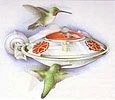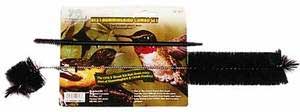Why to Feed the Last
Hummingbirds of Summer
Is it OK to keep on feeding hummingbirds, now that summer is ending? Could my feeders keep them from migrating
when they're supposed to? — August H., Sandusky, Ohio
 Actually, late summer can be the best time of year to feed hummingbirds. All the young of the year are around, and migrants are hungry. At this season many hummingbird feeders are mobbed, as migrating hummers stop off for a good meal before continuing their journeys. Actually, late summer can be the best time of year to feed hummingbirds. All the young of the year are around, and migrants are hungry. At this season many hummingbird feeders are mobbed, as migrating hummers stop off for a good meal before continuing their journeys.
Hummingbirds love feeders because the birds get a huge reward of calories for a small expenditure of effort. But sometimes conscientious hummingbird lovers worry about whether their feeders will keep the birds from their normal journey south.
Do feeders interfere with migration?
 Hummingbirds don't wait until the food disappears before they start heading south in fall. Hummingbirds don't wait until the food disappears before they start heading south in fall.
Instead, they rely on their internal yearly clocks, or circannual rhythms, to tell them when to go. Their metabolism changes. They get restless, and pretty soon they just have to fly south. Fine summer weather won't stop them. Plenty of flowers won't stop them. And your feeder sure is not going to stop them.
Shortening day length is one of the cues that help hummingbirds keep their internal clocks in time with the seasons. However, the birds get the urge to migrate even if they're confined under artificial lights, where they can't see that the days are growing shorter. It's an internal thing.
They just know, the way some people wake up at the right time without an alarm clock, or the way others get hungry at lunchtime. So the hummingbirds will go ahead and migrate, with or without feeders. But your hummingbird feeder can be a big help!
How your feeder helps hummingbirds migrate
 During migration, hummingbirds need extra nourishment to power their long flights. They have to find that fuel along their travel route. Imagine having to live off the land while making a long journey. During migration, hummingbirds need extra nourishment to power their long flights. They have to find that fuel along their travel route. Imagine having to live off the land while making a long journey.
The demands of finding enough food during migration requires hummers to have good memeories. We know that they do remember where they've found food resources on previous journeys. That's why you may see hummingbirds come and check out a spot where you hung a feeder a year ago. A hummingbird that finds your feeders to be a clean, reliable source of nourishment will come back to it on the next trip north or south, just to see if the feeder is still there.
Migration is an arduous enterprise. If anything interferes with wild food supply, such as a storm that damages wildflower blossoms, or a sudden cold snap, hummingbirds can find themselves suddenly in trouble. And your feeders could save lives.
Also, some young hummingbirds may hatch late in the season and get a late start on migration. Your feeder can be part of the difference that lets such a bird stay alive until it's mature enough and has enough fat stored up to make its journey south.
About cleanliness
It's important to keep a feeder clean. Never leave the same old solution in a feeder for more than a week, and be ready to change much more often than that. In warm weather, sugar water can spoil and ferment in a couple of days. If the solution turns cloudy, it's spoiled. If there are bits of dark mold forming, the solution is way spoiled.
Hummingbirds can get sick from mold in the solution. So keep it clean. After you mix your sugar and water, you can store the solution for at least a week in the refrigerator. That makes it easy to clean and replenish your feeders frequently. (See recipe for hummingbirds' nectar.)
 To clean a hummingbird feeder, rinse it in water and use a bottle brush to scrub out the inside. For this purpose, we like a combination of brushes we found in the Hummingbirds' Best Brush Kit, which comes with two brushes. A bottle brush lets you clean inside long hummingbird feeders. (It even reaches into feeders with small openings, like the Hummingbird Lanterns, which are made out of bottles.) To clean a hummingbird feeder, rinse it in water and use a bottle brush to scrub out the inside. For this purpose, we like a combination of brushes we found in the Hummingbirds' Best Brush Kit, which comes with two brushes. A bottle brush lets you clean inside long hummingbird feeders. (It even reaches into feeders with small openings, like the Hummingbird Lanterns, which are made out of bottles.)
We especially like the port brush, which is a tiny brush designed to clean the small holes through which the hummingbirds feed. It's especially important not to let mold form in those spots, because they're right in contact with the hummingbirds' tongues.
And what gardens contribute to hummingbirds
 Gardens with nectar-giving flowers are humming with activity in late summer. In the Birdwatching Dot Com garden, ruby-throats visit the hummingbird sage about every five minutes. We now choose our flowers more for what will feed hummingbirds than by mere color schemes. Gardens with nectar-giving flowers are humming with activity in late summer. In the Birdwatching Dot Com garden, ruby-throats visit the hummingbird sage about every five minutes. We now choose our flowers more for what will feed hummingbirds than by mere color schemes.
 Fortunately, a garden designed to attract hummingbirds appeals to the human aesthetic sense also. And a couple of beautiful hummingbird feeders hung among the flowers are garden ornaments in their own right. Fortunately, a garden designed to attract hummingbirds appeals to the human aesthetic sense also. And a couple of beautiful hummingbird feeders hung among the flowers are garden ornaments in their own right.
So go right ahead and keep putting out food for your humingbirds, with a clear conscience. As long as your feeders are clean and the sugar water is fresh, you're helping, not hurting, your hummingbird friends.
-- Diane Cooledge Porter
Text © 2008 by Diane Porter
Photos of hummingbirds 2008 © Michael and Diane Porter
Related articles:
Hummingbird feeders
Recipe for hummingbirds' nectar
4-second QuickTime hummingbird movie
|



